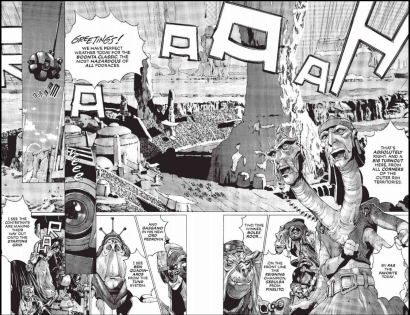As The Rise of Skywalker brings the Star Wars saga to its official close, now seems like the right time to revisit the very first chapter in the series, The Phantom Menace. Episode I debuted in 1999, making the leap from screen to print the following year with Kia Asamiya providing the illustrations. Readers familiar with Asamiya’s Silent Möbius will immediately understand why he was tapped for this project: he has a penchant for drawing detailed space ships and cityscapes, two important qualifications for translating George Lucas’ vision into a compelling comic.
Alas, Asamiya was also saddled with Lucas’ original script, leaving him little room to make the story more interesting on the page than it was on the screen. Asamiya faithfully preserves the film’s most frustrating elements—the tin-eared dialogue, the unfortunate minstrelsy of JarJar Binks—as well as its surfeit of plot points, secondary characters, and clumsy discussions of Federation trade policy. To his credit, Asamiya’s version is brisk and streamlined in contrast with Lucas’, marching from one scene to the next with a sense of urgency that’s often lacking from the film. Some of the film’s most tedious scenes—the blockade of Naboo, the first interactions between Padme and Anakin, the Imperial Senate’s deliberations—have been telescoped, giving Asamiya room for more detailed treatments of chases, light saber fights, and space battles.
The artwork, on the other hand, is a hit-or-miss affair. Asamiya’s skill at drawing aliens, robots, space craft, and futuristic cities is unquestionable; his evocation of Otoh Gunga and Coruscant do justice to the complexity and specificity of Lucas’ original designs, while Asamiya’s establishing shots of Naboo convincingly evoke the planet’s lush jungles and Greco-Roman palaces without the added benefit of color. His ability to compress lengthy action sequences is likewise impressive; in just a few artfully constructed pages, for example, he captures the excitement and danger of Anakin Skywalker’s pod race, using panels-within-panels to juxtapose the racers’ progress with the crowd’s ecstatic reaction to the event:
Asamiya’s human characters, by contrast, are as expressionless as their big-screen counterparts—a key failing, as the characters register as pawns, not people, dutifully shuttled from one scenario to the next with almost no sense of how the violence and chaos they’ve encountered has affected them. Only the two principle non-human characters—JarJar Binks and C3PO—are drawn in an animated fashion, providing the series’ few moments of genuine emotion and surprise.
And that, in a nutshell, is why Asamiya’s take on The Phantom Menace is so frustrating: it improves on certain aspects of the source material while emphasizing its fatal flaws, making for an efficient but affectless gloss on Lucas’ original story that reads a lot like Cliff Notes. Not recommended.
STAR WARS: EPISODE I – THE PHANTOM MENACE, VOLS. 1-2 • ART BY KIA ASAMIYA • MARVEL COMICS • NO RATING (SUITABLE FOR READERS 10 AND UP)

 I like science fiction, I really do, but I have limited tolerance for certain tropes: futures in which all the women dress like strippers — or worse, fascist strippers — futures in which giant bugs menace Earth, and futures in which magic and technology freely commingle. Small wonder, then, that Kia Asamiya’s Silent Möbius has never been on my short list of must-read manga — it’s a festival of cheesecake, gooey monsters, and pistol-packing soldiers who, in a pinch, must decide whether to cast a spell or fire a rocket launcher at the enemy. Imagine my surprise when I discovered just how entertaining Silent Möbius turned out to be, gratuitous panty shots, bugs, and all.
I like science fiction, I really do, but I have limited tolerance for certain tropes: futures in which all the women dress like strippers — or worse, fascist strippers — futures in which giant bugs menace Earth, and futures in which magic and technology freely commingle. Small wonder, then, that Kia Asamiya’s Silent Möbius has never been on my short list of must-read manga — it’s a festival of cheesecake, gooey monsters, and pistol-packing soldiers who, in a pinch, must decide whether to cast a spell or fire a rocket launcher at the enemy. Imagine my surprise when I discovered just how entertaining Silent Möbius turned out to be, gratuitous panty shots, bugs, and all.